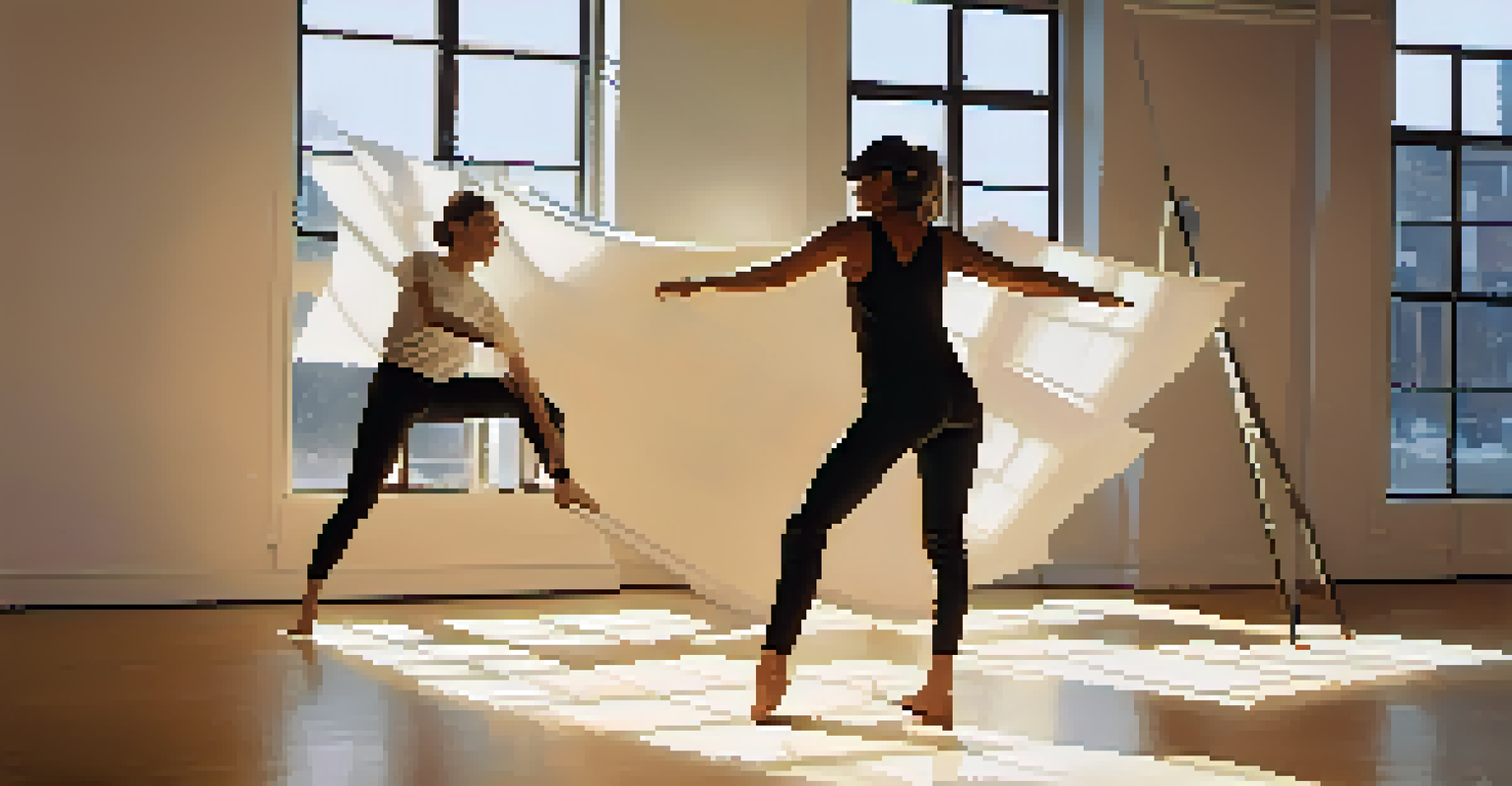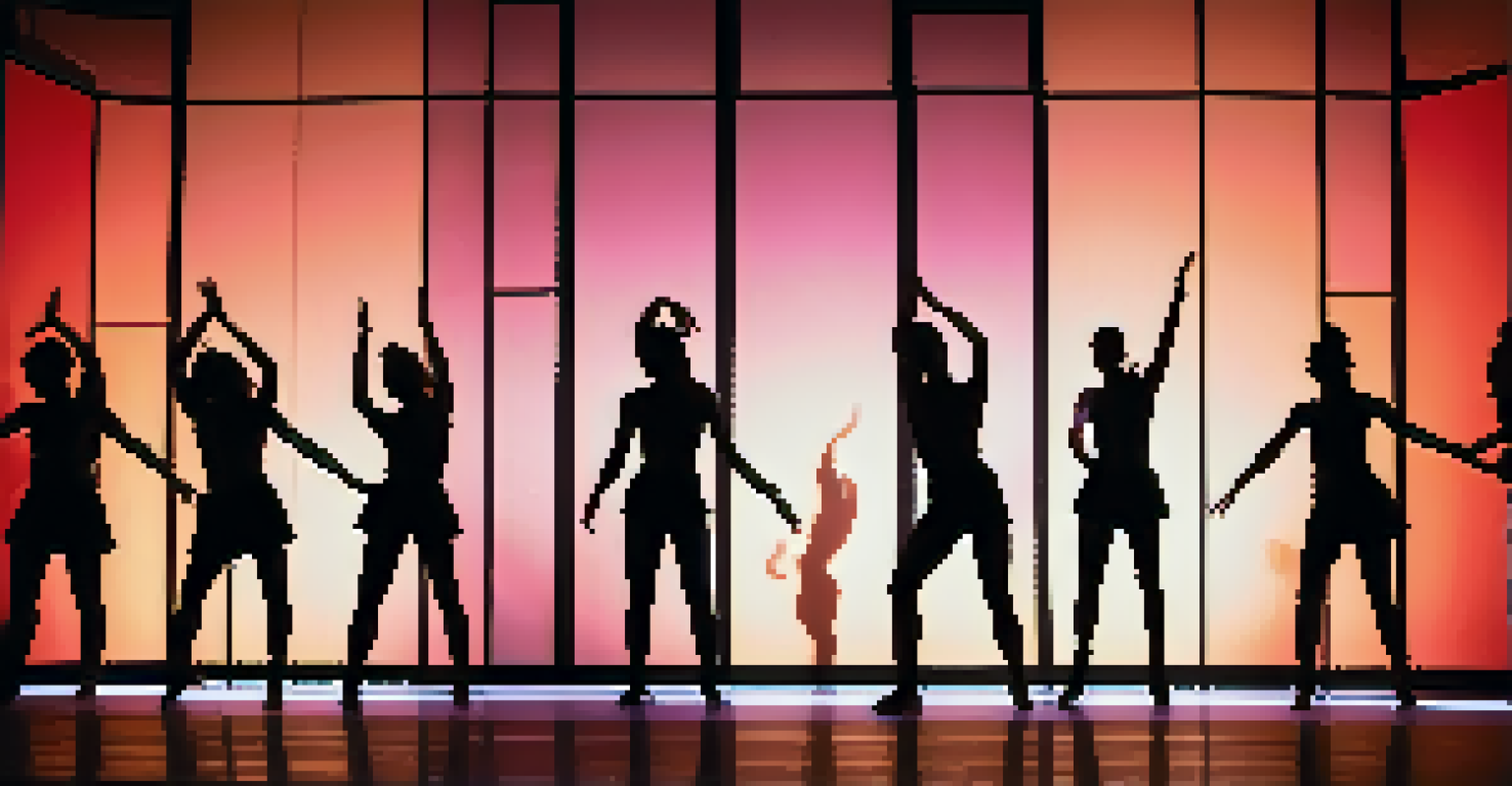Dance Collaboration: A Study of Movement and Visual Art

The Intersection of Dance and Visual Art
Dance and visual art may seem like distinct realms, but they share a profound connection. Both art forms express emotions and tell stories, albeit through different mediums. When combined, they create a rich tapestry that enhances the viewer's experience, inviting them to engage on multiple sensory levels.
Dance is the hidden language of the soul.
For instance, consider a dance performance set against a backdrop of vibrant paintings. The dancers' movements can echo the colors and shapes of the artwork, creating a dialogue between the two. This fusion not only captivates the audience but also deepens their understanding of both art forms.
Moreover, this collaboration can challenge traditional boundaries, encouraging artists to step outside their comfort zones. By experimenting with the interplay of movement and visual elements, creators can discover new artistic possibilities that inspire innovation and creativity.
Historical Context: Dance and Visual Art Through Time
The collaboration between dance and visual art is not a modern phenomenon; it has historical roots that date back centuries. From the early days of ballet, where elaborate sets and costumes were integral to the performance, to contemporary installations that integrate dance, the two arts have influenced each other significantly.

In the 20th century, artists like Martha Graham and Jackson Pollock explored this relationship further, with Graham's choreography reflecting Pollock's abstract expressionism. Such collaborations often lead to groundbreaking works that challenge traditional artistic conventions and invite new interpretations.
Dance and Art: A Symbiotic Relationship
The fusion of dance and visual art enhances emotional expression and storytelling, creating a richer experience for audiences.
These historical examples serve as reminders of the ongoing evolution of both dance and visual art. They highlight how artists can draw inspiration from one another, creating works that resonate with audiences on deeper levels and push the limits of creativity.
The Role of Technology in Dance and Visual Art Collaborations
In today's digital age, technology plays a crucial role in enhancing dance and visual art collaborations. From projection mapping to virtual reality, artists are exploring innovative ways to merge movement with visual experiences. These tools allow for dynamic storytelling that can captivate audiences in entirely new ways.
Art is not freedom from discipline, but disciplined freedom.
For example, a dance performance enhanced by live video feeds can create a sense of immediacy and connection between the dancers and the audience. This technology not only elevates the performance but also invites viewers to engage interactively with the art.
As technology continues to evolve, so too does the potential for collaboration. Artists are now able to reach broader audiences and experiment with new formats, leading to exciting and unexpected outcomes in the world of dance and visual art.
Case Studies: Successful Dance and Visual Art Collaborations
Examining successful collaborations can provide valuable insights into the art of blending dance with visual elements. One notable example is the partnership between choreographer Crystal Pite and visual artist Osbert Parker. Their productions showcase how the fluidity of dance can interact beautifully with visual storytelling.
Another inspiring case is the work of the renowned dance company Pilobolus, known for its innovative use of shadow and light. Their performances often incorporate large-scale visual elements, creating a stunning interplay of movement and imagery that leaves audiences in awe.
Historical Roots of Collaboration
The interplay between dance and visual art has evolved over centuries, with historical figures paving the way for innovative artistic expressions.
These case studies demonstrate the power of collaboration in creating art that resonates deeply with viewers. By observing their techniques and approaches, emerging artists can glean lessons that inform their own creative practices.
The Creative Process: Collaborating Artists' Perspectives
The creative process behind dance and visual art collaborations can be both exhilarating and challenging. Artists often find themselves navigating differing perspectives and approaches, which can lead to rich discussions that enhance the final product. Communication and mutual respect are vital in fostering an environment where creativity can flourish.
For instance, a choreographer might have a specific vision for a dance piece, while a visual artist envisions a complementary visual landscape. Finding common ground between these ideas requires open dialogue and a willingness to experiment.
Ultimately, the collaboration itself can become a work of art. The journey of merging two distinct forms can lead to unexpected breakthroughs, allowing artists to redefine boundaries and discover new dimensions in their craft.
Audience Engagement: The Impact of Collaborative Art
The synergy between dance and visual art not only transforms the artists involved but also profoundly impacts audiences. Viewers are often drawn into the experience, as the combination of movement and visual elements creates a multi-layered narrative that captivates the senses. This engagement can lead to a deeper appreciation for both art forms.
Many audience members report feeling a heightened emotional response when experiencing collaborative performances. The dynamic interplay of dance and visual art can evoke powerful feelings, prompting introspection and connection.
Technology Expands Artistic Horizons
Advancements in technology, such as virtual reality and augmented reality, are revolutionizing how dance and visual art collaborate and engage audiences.
Moreover, these collaborations often encourage discussions around art, movement, and culture, enriching the community's understanding of creativity. As audiences become more engaged, they also become advocates for the ongoing exploration of such collaborations in the future.
Future Directions: Evolving Dance and Visual Art Collaborations
As we look to the future, the potential for dance and visual art collaborations seems boundless. Emerging trends in technology, such as augmented reality and interactive installations, are set to reshape how audiences experience art. These innovations present exciting opportunities for artists to explore new dimensions in their work.
Furthermore, the growing emphasis on inclusivity and diversity in the arts is likely to influence future collaborations. By incorporating a broader range of voices and perspectives, artists can create richer and more resonant experiences that reflect our multifaceted world.

Ultimately, the evolution of dance and visual art collaborations will continue to inspire artists and audiences alike. As they push the boundaries of creativity, we can anticipate a vibrant landscape of artistic expression that invites everyone to participate and engage.